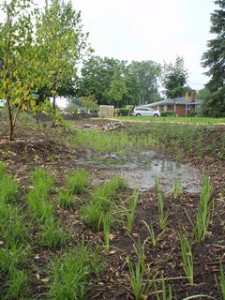
Infrastructure is the foundation of modern living. It consists of roads, bridges, buildings, pipes, cables, parking lots and more, providing important resources such as communication, transportation, economic development, safety, and artistic expression.
Yet there is a side to infrastructure that has often been overlooked in human development: green infrastructure (GI). If railroads and buildings can be called gray infrastructure, then open spaces, wetlands, streams and rivers are green infrastructure. The ecosystem services they provide have always supported and protected our towns and cities, but only recently have we come to appreciate and quantify their value. Through GI, our water is cleaned, our natural settings are preserved, local wildlife has habitat, and our temperatures are moderated . . . all free of charge. (Thanks, nature!)
Naturally-occurring GI, such as wetlands and meandering streams, can be mimicked through human-constructed GI for the purpose of managing stormwater. Designers and engineers now construct bioswales, rain gardens, green roofs, use permeable pavement, and incorporate other various site-specific infiltration designs. The point of these projects is to draw stormwater into the groundwater instead of piping it quickly into streams, where it carries pollution, raises the water temperature (from hot roofs and pavement), and causes flashy, eroding creeks. Vegetated GI features capture rain water, filter it through the soil, cool it, and slowly deliver it to streams via groundwater.
While green infrastructure includes rain gardens and bioswales, each of these features would be more accurately described as Low Impact Development (LID), or the implementation of best management practices at a site-specific level. GI, like grey infrastructure, expands the same idea to a community-wide scope. Its focus is on the planned, strategic placement of LID features and on the accounting of reduced stormwater volume and pollutant loads those features provide. It requires planning and inter-jurisdictional communication.
Gray infrastructure and GI are similar in some ways, but differ in others:
Gray Infrastructure…
- Removes stormwater and delivers it to local streams quickly
- Overlays or replaces natural systems with impervious structures
- Requires planning and costly maintenance
- Requires upgrading to accomodate increased stormwater flow that results from development and climate change
- Is limited to stormwater-removal benefits such as flood reduction
Green Infrastructure…
- Treats stormwater on-site and delivers it to streams slowly
- Incorporates natural systems
- Requires planning and less-costly maintenance
- Can supplement grey infrastructure to prevent major system upgrades
- Has multiple, quantifiable benefits beyond stormwater-removal
Green Infrastructure and Sustainability
A community that incorporates GI alongside gray infrastructure for stormwater management promotes sustainability. The economic benefits of GI have been shown to outweigh those of grey infrastructure, especially at the community-wide scale (see, e.g., EPA’s 2007 “Reducing Stormwater Costs through Low Impact Development (LID) Strategies and Practices” and Center for Neighborhood Technology’s “Value of GI,” American Rivers’ “Banking on Green,” and numerous others). In addition, GI helps protect water quality and aquatic ecosystems. It retains a natural landscape aesthetic, which increases property values and quality of life. It provides habitat for local and migrating birds and wildlife. GI is a smart choice for stormwater management because of its many benefits.
Interested in learning more? Great!
Download these documents:
- Barriers Preventing Green Infrastructure Development
- Green Infrastructure Communications Strategy
- A Green State Street Design Concept



